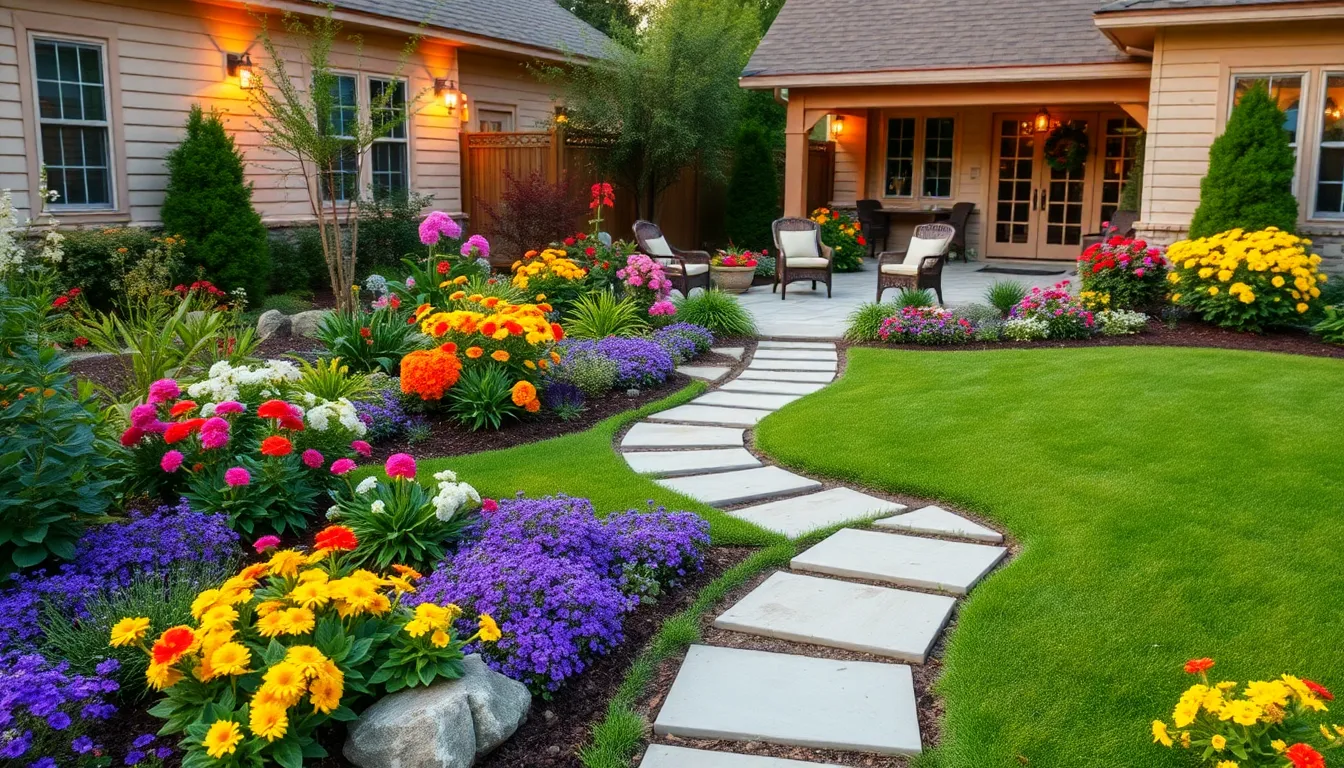Imagine stepping into your backyard and feeling like you’ve just entered a botanical paradise. Landscaping and gardening aren’t just about planting a few flowers and calling it a day; it’s an art form that transforms ordinary spaces into extraordinary retreats. Whether it’s creating a lush oasis for relaxation or a vibrant playground for the kids, a well-designed landscape can elevate any home.
Landscaping and Gardening
Landscaping and gardening significantly enhance outdoor spaces. These practices create inviting environments, improve aesthetics, and contribute to property value.
The Importance of Landscaping
Landscaping shapes visual appeal and functionality. A well-designed landscape adds beauty and creates spaces for leisure and entertainment. Effective landscaping manages water runoff, thus promoting environmental health. It can also reduce energy costs; strategically placed trees provide shade during summer. Employing indigenous plants encourages local biodiversity, creating a habitat for various species.
Benefits of Gardening
Gardening offers numerous health benefits. Engaging in gardening promotes physical activity, improving cardiovascular health and muscle strength. Mental well-being also sees benefits; interaction with nature can reduce stress and anxiety. Fresh produce from home gardens enhances diets, providing organic fruits and vegetables. Community gardening fosters connections among individuals, strengthening neighborhood ties. Skills learned through gardening also include responsibility, patience, and an appreciation for nature.
Types of Landscaping

Landscaping encompasses various styles tailored to different needs. Understanding the two primary types can enhance the outdoor appeal of any property.
Residential Landscaping
Residential landscaping focuses on enhancing private properties. It often prioritizes aesthetics and functional outdoor spaces. Common elements include gardens, lawns, and patios. Utilizing native plants fosters sustainability and minimizes maintenance. Moreover, features like walkways, lighting, and water elements add depth to settings. Homeowners often seek designs that reflect personal style while creating inviting atmospheres for relaxation and entertaining. Achieving harmony between natural beauty and practicality remains paramount.
Commercial Landscaping
Commercial landscaping emphasizes creating professional and inviting environments for businesses. Designs often prioritize functionality alongside visual appeal. Elements such as trees, shrubs, and seasonal flowers contribute to curb appeal. Additionally, maintaining green spaces can improve worker productivity and client perceptions. Incorporating outdoor seating areas enhances usability. Effective designs consider aspects like safety and accessibility. Investing in quality landscaping can significantly elevate a company’s image and property value.
Essential Gardening Techniques
Gardening techniques form the foundation for a thriving garden. Mastering these skills guarantees success and enhances the overall experience.
Soil Preparation and Maintenance
Soil quality determines plant health and growth. Testing soil pH helps evaluate nutrient levels and acidity. Amendments like compost improve soil structure while boosting fertility. Regular mulch application retains moisture and suppresses weeds. Rotating crops each season combats pests and enhances soil stability. Monitoring drainage prevents waterlogging, which can harm roots.
Plant Selection and Arrangement
Choosing the right plants ensures a vibrant garden. Native species thrive with less maintenance, promoting biodiversity. Grouping plants by light and water needs maximizes growth potential. Mixing perennials and annuals creates year-round visual interest. Considering plant height and spread fosters balanced arrangements. Incorporating ornamental features enhances aesthetic appeal. Understanding seasonal blooms allows for continuous color throughout the year.
Tools and Equipment for Landscaping and Gardening
Essential tools and equipment play a vital role in effective landscaping and gardening. These items help individuals create beautiful outdoor spaces while enhancing their gardening experience.
Basic Gardening Tools
Gardening shears come in handy for pruning plants and shaping gardens. A trowel is essential for digging holes and transferring soil. Garden gloves protect hands from thorns and rough surfaces, ensuring comfort during tasks. Rakes help in clearing debris and leveling soil, promoting healthy plant growth. Watering cans and hoses provide necessary hydration to plants, meeting their needs efficiently. Each of these tools contributes significantly to maintaining a thriving garden.
Landscaping Equipment
Lawn mowers facilitate the upkeep of grass, ensuring a neat appearance in any landscape. String trimmers edge around flower beds and pathways, creating defined boundaries. A shovel serves multiple purposes, including digging, planting, and moving materials. Wheelbarrows transport soil, plants, and other materials, easing the workload during projects. Landscaping fabric provides effective weed control while allowing water and nutrients to reach plants. Investing in quality landscaping equipment ensures sustainability and efficiency throughout the landscaping process.
Future Trends in Landscaping and Gardening
Landscaping and gardening continually evolve with new trends that prioritize sustainability and technology. These developments shape outdoor spaces, making them more functional and appealing.
Sustainable Practices
Sustainable practices in landscaping and gardening focus on environmental health. Native plants are chosen for their low water needs and resilience, contributing to biodiversity. Water-efficient irrigation systems help reduce waste, while organic gardening methods eliminate harmful chemicals. Composting enriches soil and minimizes waste, ensuring healthy plant growth. Pollinator-friendly gardens attract bees and butterflies, supporting ecosystems and ensuring vibrant gardens. Implementing these practices promotes a healthy balance between aesthetics and environmental stewardship.
Technology Integration
Technology integration enhances landscaping and gardening efforts. Smart irrigation systems optimize water usage by adjusting to weather conditions. Drone technology assists landscape designers by providing aerial views, allowing for better planning and execution. Garden management apps help track plant care schedules, monitoring moisture levels and nutrient needs through notifications. Furthermore, landscape design software enables the creation of detailed 3D models, making it easier to visualize projects before implementation. Combining these advancements streamlines outdoor projects and ensures efficient resource use, reflecting modern gardening practices.
Conclusion
Landscaping and gardening offer a unique opportunity to elevate outdoor spaces while fostering well-being. By embracing these practices, individuals can create inviting environments that reflect personal style and enhance property value.
The focus on sustainability and innovative techniques ensures that these endeavors not only beautify but also contribute positively to the environment. As trends evolve, the integration of technology and eco-friendly practices will continue to shape the future of landscaping and gardening.
Ultimately, investing time and effort into these areas can lead to vibrant, functional spaces that provide joy and tranquility for years to come.

